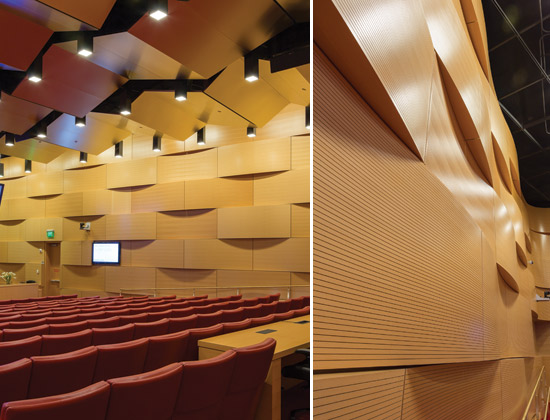Total Acoustical Design
Taking a holistic approach to controlling sound in spaces yields the best results
![]() Continuing Education
Continuing Education
Use the following learning objectives to focus your study while reading this month’s Continuing Education article.
Learning Objectives - After reading this article, you will be able to:
- Analyze and explore the fundamentals of interior acoustical design treatment and their relationship to overall building design.
- Examine traditional and emerging acoustical system options available to provide sound control treatments that enhance interior design schemes.
- Assess the contribution that good acoustical design makes toward improved indoor environmental quality in green and sustainable building design.
- Recognize and identify the elements that make up a holistic approach toward acoustical design and beneficial sound control.
Good acoustical design encompasses controlling all aspects of sound entering, leaving, or being generated within a space. Desirable sounds, such as speech, music, or other communication, are best received if the spaces where they originate are designed to help them resonate clearly. Unwanted sound from outside of a building can be distracting or even harmful to people inside. Sound flowing between rooms or spaces in a building in all directions (i.e. through walls, floors, ceilings, etc.) can create similar negative indoor experiences. All of these aspects of sound in a building are important to a successful design much the same way designing a building to use desirable light while controlling undesirable glare is important. By taking a holistic approach to acoustical design as an integral part of architectural and interior design, a comprehensive, successful result can be achieved.
Sound Principles: Acoustic Basics
Sound is energy that radiates from a source. It moves through the air just like other energy does (i.e. heat energy or light energy) which means that it can move through air-filled openings in buildings too. Sound energy can also penetrate a wall, ceiling, or floor similar to the way heat does. Professionals, specialists, and scientists have studied sound in terms of its generation, its transmission through space (airborne sound) and objects (structure-borne sound), and its reception by people. As such, a significant body of knowledge is available on how to deal with sound in human environments as part of the field we know as acoustics or acoustical design.
Sound is typically characterized both by loudness and frequency. Loudness is measured in decibels (dB) such that the higher the dB rating, the louder the sound. The commonly referenced range is 0 dB (threshold of hearing) to around 130 dB (threshold of pain) with human speech being in the middle at around 50 to 65 dB. Sound frequency, meaning the time frequency of the radiating waves of sound, is measured in Hertz (Hz). One Hz is equal to a frequency of one cycle per second. The human ear can typically hear frequencies or sound “pitch” between about 20 Hz (very low-pitched, bass sounds) up to around 20,000 Hz (very high-pitched, piercing sounds) if the person is fairly young—older adults may hear frequencies up to about 15,000 Hz. Sound exists above and below this range, but our ears don't hear it, unlike some animals such as dogs or bats that do indeed hear very high-pitched sounds (over 20,000 Hz) or elephants that can hear lower sounds (below 20 Hz).

Photo courtesy of Ceilings Plus®
Addressing the total acoustic and aesthetic design of a space will help assure a positive experience for the users and improved indoor environmental quality all around.
Sound originates from a source such as a person talking at one basic frequency or music playing across multiple frequencies. When the sound travels to the ears of a listener, its loudness will be determined first by its original dB level then by things that can diminish it such as distance or surroundings. Whatever the makeup, it is first heard as direct sound traveling straight from the source to the listener. However, since sound radiates in all directions, it can also be affected by anything else nearby that it might reach, such as walls, floors, ceilings, etc.
Hence the full sound heard by a person within a space will be a combination of direct sound from the sources and sound reflected off the various surfaces within the space. Surfaces that are highly reflective of sound will cause it to reverberate or “bounce” back and can create an echo effect or a perception of a “very noisy” space. By contrast, surfaces that are highly sound absorptive will diminish the reflected sound waves, reduce loudness, reverberation and echoes, and help create a “quieter space.” Finding the right combination of sound absorption versus reflection for a given space is a matter of using several well-developed tools to balance the preferred acoustic characteristics within that space.
Noise Reduction Coefficient (NRC)
Individual materials can be formally tested according to ASTM C423 to measure the sound absorption rate of those materials on a scale of zero to one. Since the test determines sound absorption rates at four specific sound frequencies (250, 500, 1,000 and 2,000 Hz), the NRC rating number is actually an average of the results across those four frequencies which are generally in the range of human speech. Hence, a material with an NRC of 0.0 can be presumed to reflect back all of the sound striking it in this range (i.e. not absorb any) while a material with an NRC of 1.0 is represented to absorb all of the sound that strikes it in this range. The NRC is useful for determining the sound-absorbing characteristics of materials in many general building applications, but not for special applications where sound at other frequencies needs to be addressed.

Photo courtesy of Owens Corning
Treating interior walls with high NRC-rated sound-absorptive materials helps reduce reverberation time in rooms where speech intelligibility is important.
Reverberation Time (RT)
Moving from materials to a space or room, RT is used as a measure of the persistence of sound after it originates within a room. It is measured as the time in seconds that it takes for the sound level to decay by 60 dBs. Controlling or minimizing RT is particularly important in rooms where people are listening to someone speaking since it directly affects the ability to understand the spoken word, which is referred to as “speech intelligibility.” Long reverberation times mean that the listener will be subjected to reflected sound with long delay times relative to the direct sound from the talker, and these late reflections will result in “overlaps” of spoken words, making it more difficult to understand. Note that RT is also frequency specific, meaning that different frequencies can have longer or shorter signatures within the same space.
Sabin
This is the measure of the total sound absorption provided by an individual sound absorber such as a ceiling baffle when installed within an architectural space. Absorption in Sabin is measured according to ASTM C423. The number of Sabin per unit is approximately equal to the total surface area of the unit (in square feet) that is exposed to sound, multiplied by the absorption coefficient of the material.
Sound Management: Controlling Sound Within a Space
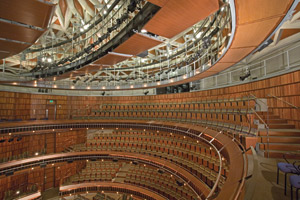
Photo courtesy of Rulon International
Sound radiates throughout a space and will be influenced by the size and shape of the space as well as the materials it encounters before it is heard by listeners.
Recognizing that sound will react not only to the room size and shape but also to the materials used in a room or space then we can also recognize our ability to control that reaction by design. The details of how to optimize that design will vary by use of course (e.g. a small classroom has different needs than a large auditorium or concert hall) but the basic principles and tools will be the same. First of all, it will be critically important to pay attention to the sound qualities of all materials exposed in the space such as ceiling treatments, wall coverings, and floor surfaces. All of these will have a range of sound absorption properties (whether tested or not) and will contribute to the overall RT of the room.
When addressing interior design, it is often the case that designers and acoustical consultants struggle with trade-offs between aesthetic preferences and acoustical performance. But that no longer needs to be the case. Innovators in the ceiling and wall panel industry have brought many new material options to suit the demands of architects, interior designers, and acousticians alike. Further, by offering custom solutions with variable acoustical options, product manufacturers are making it easier for architects to work together with their acoustic consultants in a more comprehensive approach. Some of these choices and innovations are discussed further as follows.
Sound Absorbers
Spaces that need to control reverberation times in rooms are typically in need of sound-absorptive materials with high NRC ratings. Toward that end, manufacturers offer a full range of high-performance, high-style acoustical wall and ceiling solutions for commercial interiors. These can include standard and custom acoustical wall panels made of fabric, fibrous materials, mineral tile, or acoustically treated wood products. They are available in a full range of sizes, shapes, and colors and can significantly reduce echoes and reverberation in a room while still enhancing an overall interior design scheme.
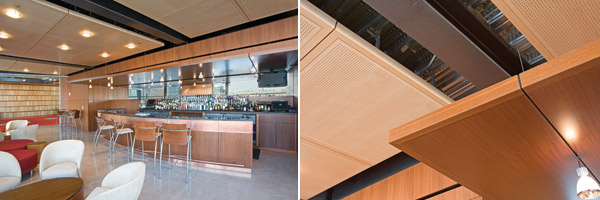
Photos courtesy of Rulon International
Acoustically treated wood ceiling panels are used in this public area to balance sound absorption and reflection. Perforated panels contain acoustical material behind for high absorption while solid wood panels offer the right level of sound reflection.
Sound absorption can also be applied to ceilings in the form of absorptive panels that can similarly be configured a variety of ways. Rather than being limited to suspended acoustic ceiling tile, there are many more options available to a designer today. These include free floating panel sections referred to as “clouds” that can be sized to suit the acoustic needs of the space while adding a visual focal point to the space. It is also possible to add a three-dimensional aspect to the ceiling with undulating or sculpted sections of sound-absorptive material. In tall spaces, hanging vertically oriented baffles that are designed to soak up sound and stop echoes is an option. They too can become design focal points by adding color, patterns, and visual interest to an otherwise plain ceiling space. In situations where a smooth, flat ceiling is desired, but more sound absorption than a gypsum board ceiling provides is required, there are some specialty options. For example, a European product that is also available in the U.S. offers a wide-span acoustical wall and ceiling system that is custom-installed by certified professionals and conceals its hardware for a smooth monolithic appearance. Systems like this provide the appearance of painted plaster or gypsum, yet offer superior sound absorption control.
Reflectors
In some rooms, it is desirable to help direct and channel the sound toward the listeners. In those cases, wall and ceiling surfaces need to act as large-format reflectors in a pattern appropriate to the room configuration and use. This is particularly true in performance venues with larger spaces containing a fixed stage and fixed seating. In this application, carefully placed reflectors can very effectively direct the sound coming off the stage to every seat in the house, making for a better listener experience. In order to maintain the aesthetic design requirements for this type of performance space, the reflectors can be made from a variety of materials including real wood or wood veneer over a reflective aluminum core, sometimes with an extra backer for mass. This allows for the proper mix of aesthetic and acoustic properties that can become part of the overall visual and sound qualities of the space. Since most of these installations are custom designed, complex geometries using different panel types can be provided by manufacturers as a complete system that also includes lighting trims and utility troughs. From an operations standpoint, these reflectors can sometimes be fabricated using torsion springs to allow accessibility behind them for maintenance, repairs, etc.
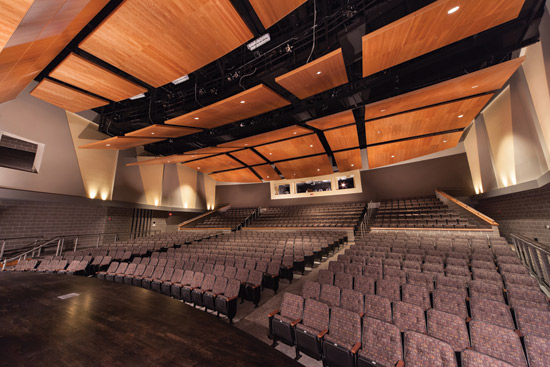
Photo courtesy of Ceilings Plus®
Sound reflectors used on a ceiling help to direct sound towards the listener and enhance the audience experience.
Random Diffusers
Not all spaces require pure sound absorption or pure reflection. Rather, many require a mix to achieve the best acoustical properties. In these situations, sound diffusion may be the best approach such that sound is dispersed somewhat randomly throughout a space. Portions of the wall and ceiling treatments are treated to be sound absorptive while other portions are reflective, all with the same or varied finishes. There are many choices available, including some manufactured modules using the same finish material that can be micro perforated and filled with sound-absorptive material in some areas or left whole in others in order to be more reflective. These modules can be arranged in a multitude of different patterns to give the designers and acousticians complete control of both the aesthetic and acoustical intent. In this way modules can be spaced in an arrangement that creates random sound diffusion with a pleasing scattering of sound reflections and still create a beautiful visual aesthetic.
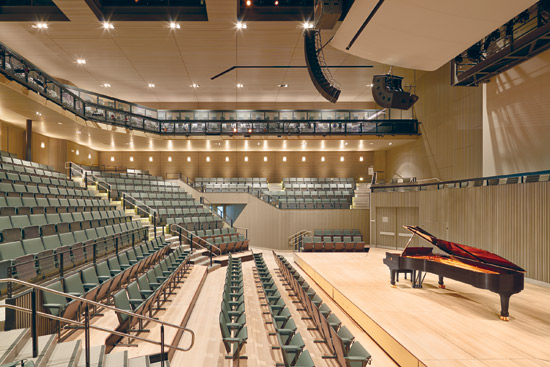
Photo © Tim Griffith, courtesy of Owens Corning
The San Francisco Jazz Center includes sound-absorbing duct liner in HVAC ductwork to eliminate unwanted background noise.
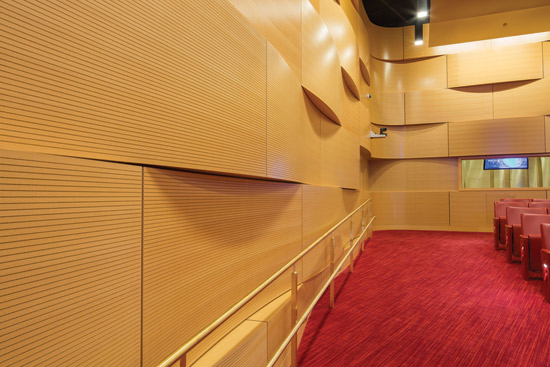
Photo courtesy of Rulon International
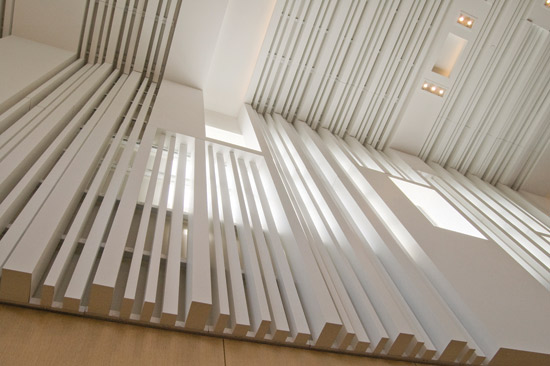
Photo courtesy of Ceilings Plus®
Undulating acoustically treated wood panels and strips of acoustical material can be arranged to create random sound diffusion and add to the visual experience of rooms as well.
Broad Band
Some spaces need to pay particular attention to the range of sound that is being controlled. Busy, active places may find that sound frequencies are being generated across a broad band—from very low-frequency background noise through mid-range conversation and operational sounds, up to very high-range music or equipment sounds. In this case, different treatments may be appropriate for different frequencies, but the aesthetic demands may require a more uniform appearance. Products are available that can achieve the needed sound control beautifully by sometimes using complex curves and undulating shapes. These systems can achieve NRC values that range from .75 to .95 making them very effective for broadband noise control in large spaces, adding to the speech intelligibility and luxury of the interior.

Photo courtesy of Ceilings Plus®
Certain spaces that need to address a broad band of sound frequencies need to be treated accordingly, particularly if their shape is prone to reflect more sound than desired.
Sound Attenuation: Limiting Unwanted Sound
In an ideal setting, the only sound that we would hear inside buildings and spaces would be the intentional, desirable ones. But, we all know that is not automatically true since unwanted sound or background noise can readily penetrate between rooms or between outside and inside. Such sound intrusion can create a lack of privacy or disrupt the normal activities of the space. This noise can originate from a variety of sources such as outdoor activity like transportation vehicles, or from indoor activity in adjacent spaces, or even from building mechanical and electrical systems. A certain amount of background noise is certainly commonplace and sometimes preferable depending on the setting. Excessive background noise however can seriously degrade the ability to understand speech, listen to music, or just communicate overall.
In order to limit or reduce the amount of noise entering or leaving a space, all components that enclose a space must be addressed. The goal is to control or attenuate the amount of sound passing through walls, ceilings, floors, etc. such that an acceptable level of background noise is achieved specific to the use of that space. Conversely it may be equally important to contain the sound in a given space so it does not spill out to other areas. Either way, there are some common and useful means to measure sound transfer and attenuation.
Transmission loss (TL) is a fundamental measurement of the ability of a material or building assembly to block or reduce sound. It is measured in decibels at different frequencies to determine how much sound transmission is lost at each measured frequency. Generally speaking, a TL of 10 means that the sound is 10 dB quieter on the listening side compared to the sound originating side.
Sound transmission class (STC) is determined by ASTM test methods to measure transmission loss specifically in interior walls. A higher STC rating (50 – 60 or above) means that more sound is blocked while a lower STC rating (35 or less) means that more sound is transmitted through. The STC number is derived from values tested at 16 different standard frequencies ranging from 125 Hz to 4,000 Hz. Acoustical engineers fit these values to the appropriate transmission loss curve to determine a final STC rating. The STC measurement is accurate for speech sounds but less so for amplified music, mechanical equipment noise, transportation noise or any sound with substantial low-frequency energy below 125 Hz.
Outdoor indoor transmission class (OITC) is a standard method used to rate the amount of transmission loss (TL) in an exterior wall setting such as determining how much traffic noise an exterior wall can stop. Compared to the STC rating, the OITC covers a lower or broader frequency range from 80 Hz to 4,000 Hz where most aircraft, rail, and vehicular traffic sounds would be found.
Ceiling attenuation class (CAC) is similar to an STC rating for walls, but is specific to suspended ceiling conditions where a dividing wall is constructed only to the ceiling height thus allowing sound to pass through a plenum space above the ceiling. As an ASTM tested measurement, it is a “two pass” test in that the sound is looked at as it transmits up through the ceiling in one space, across the ceiling plenum, and back down through the ceiling in an adjacent space. A higher CAC rating means that less sound is transferred between spaces. A ceiling system with a CAC below 25 is considered low performance, whereas one with CAC above 35 is high performance.
Impact insulation class (IIC) is a measure of the ability of a floor-ceiling assembly to absorb or deflect sound from impacts (such as people walking or objects dropping) and keep it from being transmitted to the space below. It is not a measure of airborne sound.
Noise criteria (NC) identifies the background sound level that a person experiences in a space. The NC criteria consist of a family of curves that define octave-band sound pressure levels within a building space corresponding to a chosen NC design goal. This measure is primarily applied to the sound pressure levels produced by a heating and air conditioning systems.
Sound Environment: Indoor Environmental Quality
Research has been conducted in a variety of university and clinical settings to determine the relative effects of noise on people in indoor environments. The findings have been convincing enough to determine that background noise can contribute to poorer performance in schools, longer patient recovery times in healthcare settings, and detrimental health effects to employees. This has led to the development of national standards such as ANSI Standard S12.60 “Acoustical Performance Criteria, Design Requirements and Guidelines for Schools” which establishes some very stringent thresholds for background noise. Specifically, for core learning spaces of 20,000 cubic feet or less, the one-hour steady-state background noise levels should not exceed 35 dB, while those over 20,000 cubic feet should not exceed 40 dB. This is the same low level of sound that one would experience in a quiet office. There is a caveat however that if the noisiest one-hour period during which learning activities take place is dominated by transportation noise, these maximum noise limits can each be increased by 5 dB. Within classrooms, ANSI S12.60 also identifies required RT limitations in order to maintain speech intelligibility.
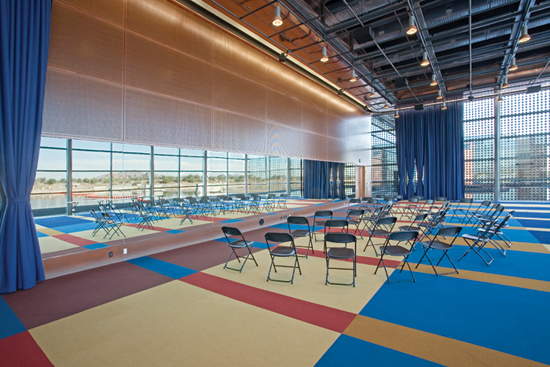
Photo courtesy of Rulon International
Instructional spaces are particularly sensitive to good acoustics such that national standards have been developed for sound control in these settings.
ANSI S12.60 has also been recognized by the U.S. Green Building Council (USGBC) as a basis for performance in the LEED® for Schools Program with specific criteria in two cases. First, there is mandated prerequisite for minimum acoustic performance in the Indoor Environmental Quality (EQ) portion of LEED. The stated intent of this prerequisite is “To provide classrooms that are quiet so that teachers can speak to the class without straining their voices and students can effectively communicate with each other and the teacher.” There is also an additional IEQ credit for “Enhanced Acoustic Performance” with a stated intent “To provide classrooms that facilitate better teacher-to-student and student-to-student communications through effective acoustical design.” Beyond schools, LEED v.4 also includes criteria for hospitals and other settings to achieve improved acoustical performance. In order to achieve this enhanced level of performance, there are a number of strategies that can be undertaken.
Sound Design: Exterior and Interior Walls
Techniques for acoustical performance in exterior and interior walls center on increasing the transmission loss or in other words, reducing the sound energy that is transmitted through walls. In exterior walls that means increasing the OITC ratings while on interior walls it amounts to increasing the STC ratings. In both cases, the essential strategy is the same.
Most wall assemblies have cavities between structural framing members. If those cavities are left to contain only air, they do nothing to impede sound transfer in walls. However, if they are filled with a sound-absorbent material, such as acoustic batt insulation or similar products, then they can absorb sound waves that penetrate the cavity. The batts are either friction fit between framing or secured via a facing onto the structure. This approach provides basic noise control in a wall structure. When using single 2x4 wood studs (16 inches o.c.) and 1/2-inch Type X gypsum board, acoustic insulation can improve conventional wood stud walls up to an STC rating on the order of STC 34 – 36.
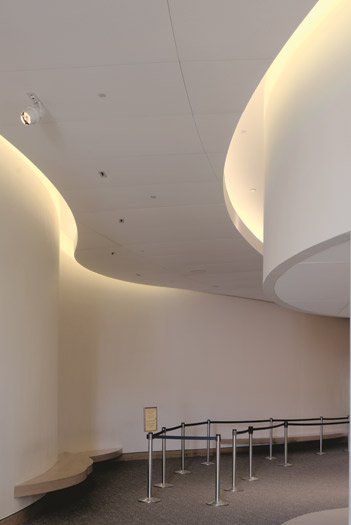
Photo courtesy of Owens Corning
Acoustically isolated walls and ceilings enhance sound quality, minimize background noise, increase the ability to concentrate, and improve speech intelligibility.
In order to obtain higher acoustical performance in walls, additional measures beyond batts are needed. A common approach is to separate the gypsum board or other wall facing material from the framing to help prevent the sound from transferring from one face to the other. This can be done by installing resilient channels or foam insulation over the studs before the wall facing is installed. There are also pre-manufactured engineered wood studs available that are split vertically and contain metal clips to keep the two sides of the wall isolated allowing sound vibrations to be isolated thus reducing transmission through the rest of the wall. Note that this type of wall framing has limited load-bearing capabilities and manufacturer's information should be consulted. Beyond this isolation of surfaces, it is appropriate to consider all of the gaps and openings that can exist around framing and other wall materials. Using an acoustical sealant will help fill those gaps and prevent sound from being transmitted through these spaces. Acoustic sealants commonly include silicone, latex, or acrylic-based formulations acoustically engineered to block sound with non-drying and non-hardening characteristics that allow it to retain its acoustic properties over time. Acoustic sealant is available for interior and exterior applications on a variety of different surfaces including gaps between wall stud plates and subfloor, openings around electrical outlets and boxes, air ducts and boots, doors, windows and other wall and floor penetrations or gaps. Sealant can contribute to a reduction in perceived noise levels through the walls on the order of 2 to 3 dB which is significant when compared with uninsulated, conventional wood stud walls.
By paying attention to all of the details of wall construction from an acoustical perspective, it is possible to raise the STC rating of interior walls from the low 30s up to STC 57 or higher which is a notable improvement. Similar performance levels in OITC can be achieved in solid exterior walls using these techniques too, although total performance there will also need to address windows, doors, and other openings.
Higher Sound Design: Ceilings and Floors
Sound can be transmitted through ceilings and floors just as easily as through walls. At the basic level, sound can be attenuated in a manner similar to walls by adding sound absorptive insulation in ceiling and floor systems. Some is designed specifically for use over suspended ceiling panels to economically improve both noise control and possibly thermal performance in new or existing ceiling systems. When placed on top of a suspended ceiling at a floor-to-ceiling partition, this type of insulation has been shown to help reduce the transfer of sound over the partition between rooms. As such it can improve the Ceiling Attenuation Class (CAC) rating by 4-10 points.
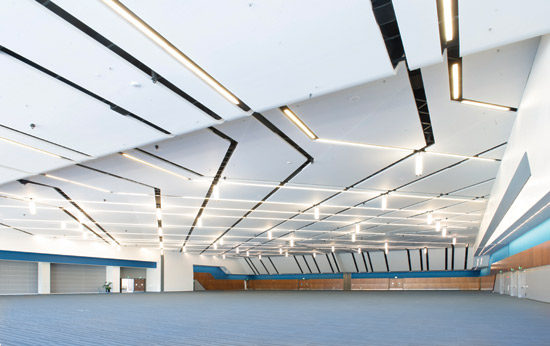
Photo courtesy of Owens Corning
Ceilings can be designed to achieve high acoustical performance using a variety of quality materials while also contributing significantly to the overall aesthetic of interior spaces.
For ceilings that are open to a metal structure or have a suspended metal ceiling, a different type of sound insulation may be appropriate. Acoustic sound blankets are available made of a variety of fibers and commonly with a black mat surface. Hence, it is excellent for eliminating light reflections while providing superior acoustical sound absorption to reduce sound transfer through the ceiling structure.
In multi-story buildings, the ceilings are also a floor for the story above. The measures described above, along with appropriate sealing, will still work very effectively in these cases for airborne sound. However the sound transmitted due to impacts need to be addressed differently. In this case, a material is needed to reduce the transmission of sound from people walking, dropping things, or operational activities. In some cases, the flooring itself can help reduce sound such as carpeting or cushioned vinyl flooring. However, that typically isn't enough to address areas with a fair bit of activity. Rather, the most effective approach is to install a continuous layer of material with a high Impact Insulation Class (IIC) rating between the subfloor and the finish flooring. Floor matting of this type is commonly composed of closed cell, extruded polyethylene foam or ethylene propylene diene monomer (EPDM). It is acoustically engineered to reduce structure-borne sound by isolating it to the room in which it is created. By placing it between the subfloor and then installing a plywood or gypsum concrete layer on top, it creates a continuous layer to isolate impacts, dissipating some energy and reflecting the remainder back into the space above. The installed plywood or gypsum concrete layer “floats” on top of the floor mat, thus providing a rigid surface for the finished flooring. The performance of these materials is dependent on the stiffness of the material and the weight of the over-layer and flooring above. Stiffer underlayment materials are needed as weight above increases.
Sound Specialties
Certain building conditions have special acoustic needs since they are subject to unique or specific sound conditions. Recognizing these needs and addressing them head on will allow for a truly comprehensive solution to good acoustic performance in buildings.
HVAC Ductwork
From an acoustical standpoint, ductwork is a wall or ceiling penetration that has the potential to bring noise into a space. That noise can come from the velocity of air movement or the design of the register such that those things should be appropriately addressed by the design professional overseeing the HVAC system. Nonetheless, ductwork may still be a conduit of other noise that needs to be controlled. The choices in this case are to add sound insulation in the ductwork leading into a space or to make the ductwork itself out of sound absorbing material.
Duct liner made from fiberglass or other sound deadening material offers noise-reducing and possible energy-saving benefits. Acoustically, duct liner is efficient at absorbing sound in the duct system and can achieve an NRC rating as high as 1.00, or completely sound absorptive under the right conditions. Some duct board products go further by creating an airtight seal within the duct which further helps to reduce noise transmission and energy leakage through the duct system. Some even feature a durable airstream smooth surface to avoid airflow resistance, help prevent fungus growth, and enable easy cleaning. These additional benefits may desirable, but they should be balanced with sound absorption rates and cost for this type of product. Fiberglass liner and duct materials possess a significantly higher sound absorption rate than these materials in comparable thicknesses and cost notably less.
High-Performance Spaces
Certain specialty spaces such as sound and music studios require particular attention to acoustical design since they often require only pure generated sound to be heard. Understanding the principles described in this article and using available materials, it is quite possible to design a room that has zero reverberation and 100% sound absorption. First, all of the available techniques to acoustically isolate all sides of space from any background noise including the walls, floor, and ceiling must be undertaken. In the case of acoustic test facilities and specialty studios, rooms are constructed completely isolated from other construction in the building.
Next, the walls, ceiling, and perhaps the floor need to be treated with appropriate sound-absorbing material. Black acoustic materials composed of inorganic fibers (i.e. fiberglass or mineral wool) or absorptive foam are common since they provide excellent sound absorption and very high NRC ratings; however foam does not usually perform as well per inch of thickness compared to fibrous materials. Properly using these materials will help provide the highest quality audio reproduction by reducing or eliminating any sound reverberation within the space. They will absorb up to 100% of the sound striking its surface depending on the specified thickness. Most of these materials are also dimensionally stable, will not shrink, warp, rot or mildew, and are noncorrosive to metals that may be used for sound recording equipment.
Conclusion
Architects and designers are well served when they take time in the design process to consider the acoustical needs of the building. Addressing the entire spectrum of sound control within individual rooms and spaces in a holistic or comprehensive manner will assure the best performance. By addressing the sound absorption, reflection, and reverberation time in a given room, the appropriate sound qualities can become part of a successful acoustic design. The multiple options available for materials and finishes allow architects and interior designers to retain control of the visual appearance of the walls, ceilings, and other surfaces. Further, by addressing the control of sound between spaces through walls, ceilings, floors, and specialty areas, each room can be appropriately shielded from background noise, unwanted sounds, and loss of privacy. Overall, this holistic, coordinated approach will yield a design that creates a very positive contribution to the total indoor environmental experience of the building.
Peter J. Arsenault, FAIA, NCARB, LEED AP, is a nationally known architect, sustainability consultant, technical writer, and continuing education presenter. www.linkedin.com/in/pjaarch
 |
 |


